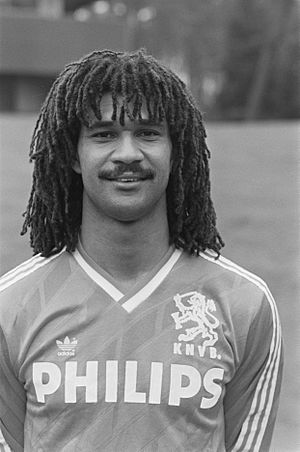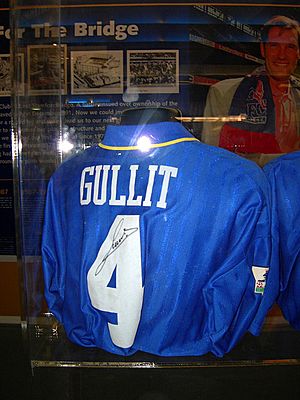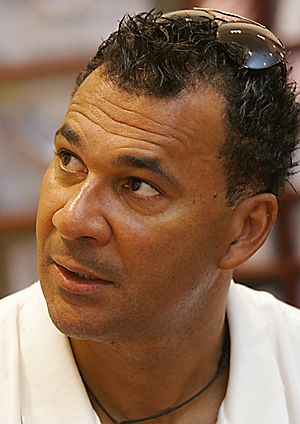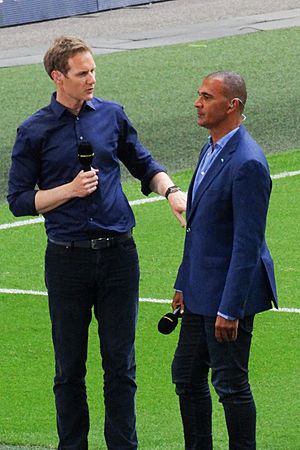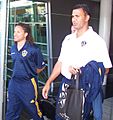Ruud Gullit facts for kids

Gullit in 2024
|
|||||||||||||||||||
| Personal information | |||||||||||||||||||
|---|---|---|---|---|---|---|---|---|---|---|---|---|---|---|---|---|---|---|---|
| Full name | Ruud Gullit | ||||||||||||||||||
| Birth name | Rudi Dil | ||||||||||||||||||
| Date of birth | 1 September 1962 | ||||||||||||||||||
| Place of birth | Amsterdam, Netherlands | ||||||||||||||||||
| Height | 1.91 m (6 ft 3 in) | ||||||||||||||||||
| Position(s) | Forward, Midfielder, Defender | ||||||||||||||||||
| Youth career | |||||||||||||||||||
| 1967–1975 | ASV Meerboys | ||||||||||||||||||
| 1975–1979 | DWS | ||||||||||||||||||
| Senior career* | |||||||||||||||||||
| Years | Team | Apps | (Gls) | ||||||||||||||||
| 1979–1982 | HFC Haarlem | 91 | (32) | ||||||||||||||||
| 1982–1985 | Feyenoord | 85 | (30) | ||||||||||||||||
| 1985–1987 | PSV | 68 | (46) | ||||||||||||||||
| 1987–1994 | AC Milan | 125 | (38) | ||||||||||||||||
| 1993–1994 | → Sampdoria (loan) | 31 | (15) | ||||||||||||||||
| 1994–1995 | Sampdoria | 22 | (9) | ||||||||||||||||
| 1995–1998 | Chelsea | 48 | (4) | ||||||||||||||||
| Total | 470 | (174) | |||||||||||||||||
| International career | |||||||||||||||||||
| 1979 | Netherlands U-21 | 4 | (1) | ||||||||||||||||
| 1981–1994 | Netherlands | 66 | (17) | ||||||||||||||||
| Managerial career | |||||||||||||||||||
| 1996–1998 | Chelsea | ||||||||||||||||||
| 1998–1999 | Newcastle United | ||||||||||||||||||
| 2004–2005 | Feyenoord | ||||||||||||||||||
| 2007–2008 | LA Galaxy | ||||||||||||||||||
| 2011 | Terek Grozny | ||||||||||||||||||
|
Medal record
|
|||||||||||||||||||
| *Club domestic league appearances and goals | |||||||||||||||||||
Ruud Gullit (born Rudi Dil on September 1, 1962) is a Dutch football legend who later became a manager. He was famous for being a very versatile player, meaning he could play well in many different positions on the field.
Gullit moved from the Dutch club PSV to the Italian club AC Milan in 1987 for a world record transfer fee at the time. At Milan, he was part of an amazing Dutch trio with Marco van Basten and Frank Rijkaard. Together, they helped Milan win three Serie A league titles and two European Cups.
In 1995, he joined Chelsea in England. A year later, he became their player-manager. He led Chelsea to an FA Cup victory, which was the club's first major trophy in 26 years. He was the first manager from outside of Great Britain to win the FA Cup.
As captain of the Netherlands, Gullit led his country to victory at the UEFA Euro 1988. He also played in the 1990 FIFA World Cup and Euro 1992. Because of his amazing talent, Gullit won the Ballon d'Or in 1987, an award for the best player in Europe. In 2004, he was named one of the 125 greatest living footballers by FIFA.
Contents
Early Life and First Steps in Football
Ruud Gullit was born in Amsterdam, Netherlands. His father, George Gullit, was from Suriname, and his mother, Ria Dil, was from Amsterdam. His father was a teacher and his mother worked at a museum.
Gullit learned to play football on the streets of Amsterdam. Street football was very important for developing his skills. His first team was a junior club called the Meerboys. When he was ten, he moved to a different part of Amsterdam and played street football with his friend, Frank Rijkaard, who also became a famous player.
Gullit then joined the DWS club, where he got noticed by the Dutch youth national team. It was at DWS that he started using his father's last name, Gullit, because he thought it sounded more like a footballer's name.
Club Career
HFC Haarlem
In 1978, at just 16 years old, Gullit signed his first professional contract with HFC Haarlem. In his first season, the team finished last in the top league, the Eredivisie. But the next season, they won the second division, the Eerste Divisie, and were promoted back to the top. Gullit was named the best player in the Eerste Divisie that year.
In the 1981–82 season, Gullit played so well that Haarlem finished fourth and qualified for a European competition for the only time in their history.
Feyenoord
In 1982, Gullit moved to the famous Dutch club Feyenoord. There, he played alongside the legendary Johan Cruyff. In the 1983–84 season, they won both the league title and the national cup. For his great performances, Gullit was named the Dutch Footballer of the Year.
While at Feyenoord, he was sometimes treated unfairly by his manager and by fans of other teams. He once called a match in Scotland "the saddest night of my life" because of how he was treated by the crowd.
PSV Eindhoven
In 1985, Gullit joined PSV. He had two amazing seasons there, scoring 46 goals in 68 league games. He helped PSV win the Eredivisie title in both 1986 and 1987. He was also named Dutch Footballer of the Year again in 1986.
AC Milan
In 1987, AC Milan paid a world-record fee to sign Gullit. He joined fellow Dutch players Marco van Basten and Frank Rijkaard at the club. This Dutch trio became one of the most famous in football history.
In his first season, Gullit helped Milan win the Italian league, called Scudetto, for the first time in nine years. The next year, they won the European Cup, the biggest club trophy in Europe. In the final against Steaua București, Gullit scored two goals in a 4–0 victory.
Milan won the European Cup again in 1990. However, Gullit suffered a serious knee injury that kept him from playing for most of that season. Even after he recovered, he had to change his style of play. Under a new coach, Fabio Capello, he played less often because of a rule that only allowed three foreign players on the field at one time.
Sampdoria
In 1993, Gullit was loaned to another Italian club, Sampdoria. He had a great season, leading them to a victory in the Italian cup, the Coppa Italia. He even scored the winning goal in a 3–2 victory against his old club, AC Milan. He briefly returned to Milan before going back to Sampdoria, where he scored 15 goals in total.
Chelsea
In July 1995, Gullit moved to England to play for Chelsea. At first, he played as a defender, but he was soon moved to his usual midfield position, where he scored six goals. His arrival, along with other international stars, helped make the Premier League more popular around the world.
Gullit loved his time in London. He once said, "Every time I played for Chelsea, I thought, 'Nice game, beautiful stadium, great crowd, I'm playing well.' It was the only time I really had fun."
International Career
Gullit made his first appearance for the Netherlands in 1981. He became a key player for his country.
His greatest achievement with the national team was winning the UEFA Euro 1988. As the team's captain, Gullit scored the first goal in the final against the Soviet Union with a powerful header. The Netherlands won 2–0, and Gullit became the first Dutch captain to lift a major international trophy.
He also played in the 1990 FIFA World Cup and UEFA Euro 1992. At Euro 1992, the Netherlands reached the semi-finals but lost to Denmark in a penalty shootout.
In 1993, Gullit had a disagreement with the national team's manager, Dick Advocaat, about his position on the field. This led to him leaving the team just before the 1994 World Cup, and he never played for his country again.
Style of Play
Gullit was a complete and versatile player. He was tall, strong, and great at jumping, but he also had amazing balance and skill with the ball. He could play as a forward, a midfielder, or even a defender.
He was known for his powerful runs, excellent dribbling, and fantastic free kicks. He was also a smart player with great vision, which allowed him to score goals and create chances for his teammates. Because of his all-around ability, he was a perfect example of "Total Football," a style where any player can take over the role of any other player on the team.
Managerial Career
Chelsea
In 1996, Gullit became the player-manager of Chelsea. In his first season, he led the team to win the FA Cup, their first major trophy in 26 years. He was the first black manager to win a major British trophy. The next season, while Chelsea was in second place in the league, he was unexpectedly sacked after a disagreement with the club's board.
Other Clubs
Gullit went on to manage Newcastle United in England, where he reached the FA Cup final. He later managed Feyenoord in the Netherlands, LA Galaxy in the United States, and Terek Grozny in Russia. His time as a manager was not as successful as his playing career.
Life After Football
After he stopped managing, Gullit became a popular football commentator and analyst for television. He is often seen on networks like BBC, Sky Sports, and BeIN Sports, sharing his expert opinions on matches.
He is also known for his work outside of football. In 1987, when he won the Ballon d'Or, he dedicated the award to Nelson Mandela, who was imprisoned in South Africa at the time. Gullit later met Mandela, who told him, "Ruud, I have lots of friends now. When I was on the inside, you were one of the few."
Gullit has also been featured as a "Legend" in the EA Sports FIFA video games, where his character is one of the best in the game.
Personal Life
Gullit has been married three times and has six children. His son, Maxim Gullit, is also a professional footballer. Gullit remains a supporter of his former club, Feyenoord.
Career Statistics
Club
| Club | Season | League | National cup | League cup | Continental | Other | Total | |||||||
|---|---|---|---|---|---|---|---|---|---|---|---|---|---|---|
| Division | Apps | Goals | Apps | Goals | Apps | Goals | Apps | Goals | Apps | Goals | Apps | Goals | ||
| HFC Haarlem | 1979–80 | Eredivisie | 24 | 4 | 0 | 0 | — | — | — | 24 | 4 | |||
| 1980–81 | Eerste Divisie | 36 | 14 | 5 | 2 | — | — | — | 41 | 16 | ||||
| 1981–82 | Eredivisie | 31 | 14 | 4 | 2 | — | — | — | 35 | 16 | ||||
| Total | 91 | 32 | 9 | 4 | — | — | — | 100 | 36 | |||||
| Feyenoord | 1982–83 | Eredivisie | 33 | 8 | 2 | 1 | — | — | — | 35 | 9 | |||
| 1983–84 | Eredivisie | 33 | 15 | 8 | 9 | — | 4 | 1 | — | 45 | 25 | |||
| 1984–85 | Eredivisie | 19 | 7 | 2 | 0 | — | 2 | 0 | — | 23 | 7 | |||
| Total | 85 | 30 | 12 | 10 | — | 6 | 1 | — | 103 | 41 | ||||
| PSV | 1985–86 | Eredivisie | 34 | 24 | 2 | 3 | — | 2 | 0 | — | 38 | 27 | ||
| 1986–87 | Eredivisie | 34 | 22 | 3 | 4 | — | 0 | 0 | — | 37 | 26 | |||
| Total | 68 | 46 | 5 | 7 | — | 2 | 0 | — | 75 | 53 | ||||
| AC Milan | 1987–88 | Serie A | 29 | 9 | 6 | 3 | — | 4 | 1 | — | 39 | 13 | ||
| 1988–89 | Serie A | 19 | 5 | 1 | 2 | — | 8 | 4 | 0 | 0 | 28 | 11 | ||
| 1989–90 | Serie A | 2 | 0 | 0 | 0 | — | 1 | 0 | 0 | 0 | 3 | 0 | ||
| 1990–91 | Serie A | 26 | 7 | 1 | 0 | — | 4 | 1 | 3 | 1 | 34 | 9 | ||
| 1991–92 | Serie A | 26 | 7 | 1 | 1 | — | — | — | 27 | 8 | ||||
| 1992–93 | Serie A | 15 | 7 | 6 | 4 | — | 4 | 0 | 1 | 0 | 26 | 11 | ||
| 1994–95 | Serie A | 8 | 3 | 2 | 0 | — | 3 | 0 | 1 | 1 | 14 | 4 | ||
| Total | 125 | 39 | 17 | 10 | — | 24 | 6 | 5 | 2 | 171 | 56 | |||
| Sampdoria | 1993–94 | Serie A | 31 | 15 | 10 | 2 | — | — | — | 41 | 17 | |||
| 1994–95 | Serie A | 22 | 9 | 0 | 0 | — | 0 | 0 | 0 | 0 | 22 | 9 | ||
| Total | 53 | 24 | 10 | 2 | — | 0 | 0 | 0 | 0 | 63 | 26 | |||
| Chelsea | 1995–96 | Premier League | 31 | 3 | 7 | 3 | 2 | 0 | — | — | 40 | 6 | ||
| 1996–97 | Premier League | 11 | 1 | 1 | 0 | 1 | 0 | — | — | 13 | 1 | |||
| 1997–98 | Premier League | 6 | 0 | 0 | 0 | 4 | 0 | 0 | 0 | 0 | 0 | 10 | 0 | |
| Total | 48 | 4 | 8 | 3 | 7 | 0 | 0 | 0 | 0 | 0 | 63 | 7 | ||
| Career total | 470 | 175 | 61 | 36 | 7 | 0 | 32 | 7 | 5 | 2 | 575 | 219 | ||
International
| National team | Year | Apps | Goals |
|---|---|---|---|
| Netherlands | 1981 | 1 | 0 |
| 1982 | 5 | 1 | |
| 1983 | 6 | 4 | |
| 1984 | 4 | 0 | |
| 1985 | 4 | 0 | |
| 1986 | 6 | 1 | |
| 1987 | 6 | 5 | |
| 1988 | 8 | 2 | |
| 1989 | 2 | 0 | |
| 1990 | 9 | 1 | |
| 1991 | 4 | 1 | |
| 1992 | 8 | 2 | |
| 1993 | 2 | 0 | |
| 1994 | 1 | 0 | |
| Total | 66 | 17 | |
Honours
Player
HFC Haarlem
- Eerste Divisie: 1980–81
Feyenoord
- Eredivisie: 1983–84
- KNVB Cup: 1983–84
PSV
- Eredivisie: 1985–86, 1986–87
AC Milan
- Serie A: 1987–88, 1991–92, 1992–93
- Supercoppa Italiana: 1992, 1994
- European Cup: 1988–89, 1989–90
- UEFA Super Cup: 1989, 1990
- Intercontinental Cup: 1990
Sampdoria
- Coppa Italia: 1993–94
Chelsea
- FA Cup: 1996–97
Netherlands
Manager
Chelsea
- FA Cup: 1996–97
Individual
- Dutch Footballer of the Year: 1984, 1986
- Dutch Golden Shoe: 1986
- Dutch Sportsman of the Year: 1987
- Ballon d'Or: 1987
- World Soccer Magazine World Footballer of the Year: 1987, 1989
- UEFA European Championship Team of the Tournament: 1988, 1992
- Premier League PFA Team of the Year: 1995–96
- Chelsea Player of the Year: 1996
- FIFA 100 (one of the 125 greatest living footballers)
- Golden Foot: 2011, as a football legend
- AC Milan Hall of Fame
- IFFHS Legends
- Italian Football Hall of Fame: 2017
Images for kids
-
Gullit (Feyenoord) in a duel against Louis van Gaal (Sparta), 1983
-
Gullit with Cobi Jones at LA Galaxy
See also
 In Spanish: Ruud Gullit para niños
In Spanish: Ruud Gullit para niños


